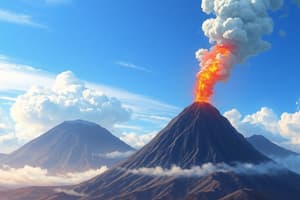Podcast
Questions and Answers
Which volcano is located in the Bicol Region?
Which volcano is located in the Bicol Region?
- Mt. Macolod
- Mayon Volcano (correct)
- Mt. Pinatubo
- Taal Volcano
All volcanoes in the Philippines are active.
All volcanoes in the Philippines are active.
False (B)
What is the process called that leads to the formation of volcanoes?
What is the process called that leads to the formation of volcanoes?
plate tectonics
What is the average density of the Earth's crust?
What is the average density of the Earth's crust?
What formed the geologic features such as volcanoes and mountains?
What formed the geologic features such as volcanoes and mountains?
The three types of seismic waves are Primary Wave, Secondary Wave, and _____ Wave.
The three types of seismic waves are Primary Wave, Secondary Wave, and _____ Wave.
Flashcards are hidden until you start studying
Study Notes
Active Volcanoes in the Philippines
- Mayon Volcano located in Albay, part of the Bicol Region, is known for its symmetry and active status.
- Mt. Pinatubo in Zambales-Tarlac erupted in 1991, marking one of the world's largest volcanic eruptions in the 20th century.
- Taal Volcano, situated in Batangas, features a complex structure and is one of the most active volcanoes in the Philippines.
Classification of Volcanoes
- Volcanoes can be classified as active or inactive based on their activity history.
- Active volcanoes are those which have erupted in recent history, while inactive ones have not shown signs of eruption for a long time.
Volcano Formation
- Volcanoes form through the movement of the Earth's crust, which involves tectonic plates colliding and buckling due to plate tectonics.
Lithosphere and Its Properties
- The lithosphere comprises the Earth's crust and is composed of various solid rocks, with an average density of 2.8 g/cubic cm.
- Thickness of the lithosphere varies from 5 to 50 km, with continental crust being thicker and less dense than oceanic crust.
- The lithosphere is in constant slow motion, contributing to geological processes.
Results of Plate Tectonics
- Plate tectonics lead to the formation of various geologic features such as volcanoes, mountains, trenches, and earthquakes.
Earthquakes
- Earthquakes are caused by vibrations within the Earth due to seismic waves.
- Seismic waves are energy waves that travel through the Earth’s layers, resulting in the occurrence of earthquakes.
Types of Seismic Waves
- Primary Waves (P-Waves): Fastest seismic waves, move through solids and liquids.
- Secondary Waves (S-Waves): Slower than P-waves, only travel through solids.
- Long Surface Waves: Travel along the Earth's surface, causing most of the damage during an earthquake.
Studying That Suits You
Use AI to generate personalized quizzes and flashcards to suit your learning preferences.




